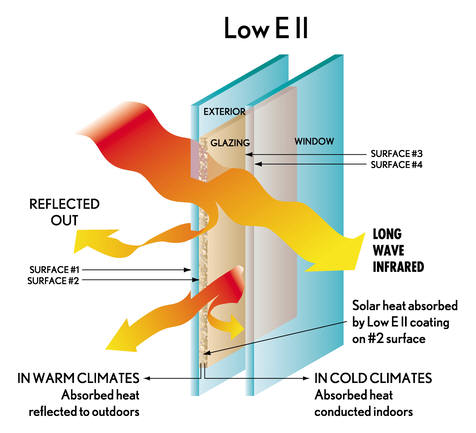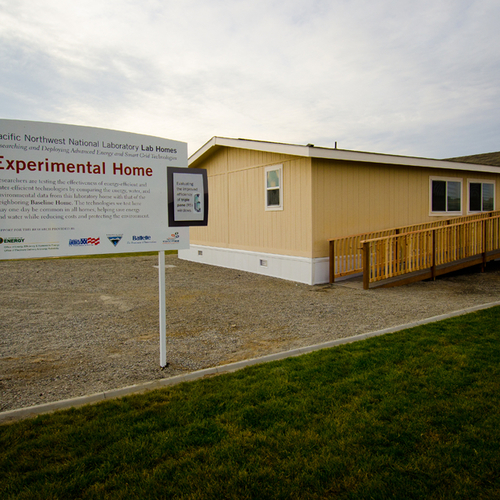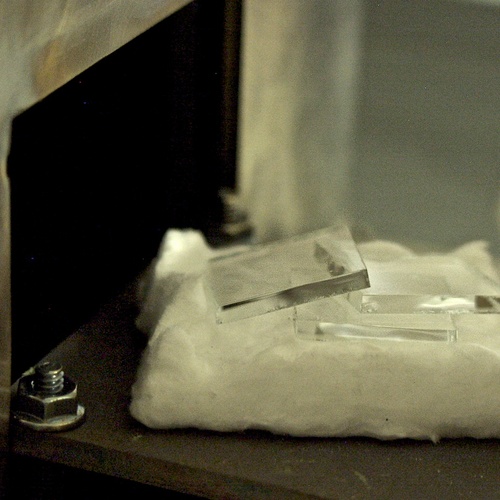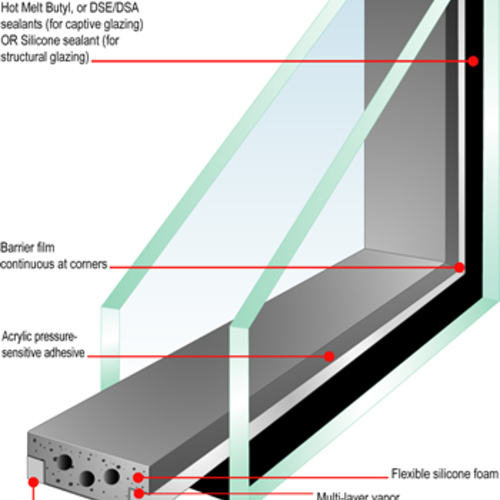
Image Credit: Marvin Windows & Doors
Last week I wrote about the early strategies window manufacturers employed to improve energy performance: adding extra layers of glass and increasing the thickness of the airspace between the layers of glass. This week we’ll look at a more revolutionary change to window design that appeared in the 1980s: low-emissivity coatings.
Make no mistake. The introduction of low-emissivity (low-e) coatings was indeed revolutionary. A lot of the initial work on low-e coatings was funded by the U.S. Department of Energy — demonstrating a role that the federal government should continue to play. A friend of mine, the late Blair Hamiliton (who later founded the Vermont Energy Investment Corporation and Efficiency Vermont), was involved in some of the earliest work on low-e coatings while at MIT.
In the mid-1970s Blair was working on technology in which a very thin, transparent coating of silver was vacuum-deposited onto a thin layer of mylar plastic that could then be suspended between two layers of glass. Properly fabricated, the plastic film was invisible, and it produced not only a triple-glazed configuration but also a way to magically reflect heat trying to escape back into the room.
How low-e coatings work
Before the physicists reading this challenge that last point, let me clarify that low-e coatings don’t really “reflect” heat. Rather, they slow the emission of radiant energy. Let’s look at the energy flows through a window.
Once the solar energy shining through a window is absorbed by surfaces in a house — say a tile floor or plaster wall — the energy warms the surface, which in turn begins radiating its own energy. That energy being radiated by the floor or wall is long-wavelength electromagnetic radiation. The glass or suspended film with the low-e coating absorbs that heat radiation (rather then transmitting it), and the low-e coating greatly limits the re-radiation — or emission — of that energy. Thus the term low-emissivity.
Some of those low-e researchers at MIT loaded their lab materials into a panel van (the “Heavy Chevy”) and moved from Cambridge, Massachusetts to Palo Alto, California where they founded Southwall Technologies in 1979. The company’s product, Heat Mirror, was rolled out commercially in 1981 — roughly doubling the R-value of a window from R-2 to R-4 and ushering in a new age of window technology.
Meanwhile, other companies were working actively on efforts to directly deposit low-e coatings onto glass. Both PPG (originally Pittsburgh Plate Glass) and Cardinal Glass introduced low-e glass in 1983, and other glass manufacturers soon followed suit. Over the next two decades, low-e coatings that were directly deposited onto the glass captured the vast majority of the market — and they continue to dominate today. While Southwall is still producing great product and a number of window manufacturers are incorporating its Heat Mirror film into windows, directly coated low-e glass is far more common today.
Where should the low-e coating be installed?
To be most effective in climates where you want to block heat loss but allow beneficial solar gain to enter, the low-e coating should be located on the outer surface of the inner pane of glass — in the window industry, this is known as the #3 surface (in denoting surfaces, you always start with the outermost surface). In warmer climates where you’re more concerned with keeping unwanted heat out, the preferred location for the low-e coating is the #2 surface (the inner face of the outer pane of glass). I remember seeing a European window a few years ago — it must have been German or Austrian — with a sash designed to be flipped seasonally to optimize the low-e coating placement, illustrating that point.
While those low-e placements (#2 or #3 surface) are preferred, having the coating on the other surface isn’t the end of the world. The difference between the overall energy performance of the window with the #2 vs. #3 surface in any climate is far less significant than the the difference between having a low-e coating and not having one. Some manufacturers only put the low-e on the #2 surface, citing concern about seal failure when the coating is on the #3 surface. That’s not a huge problem even in a cold climate.
With low-e coatings directly deposited onto the glass there are two broad categories: soft-coat and hard-coat. With soft-coat low-e, a thin layer of silver is deposited onto the glass through a sputtering process after the glass has been manufactured. While the earliest soft-coat low-e had a single layer of silver, coatings with two layers (low-e squared) and three layers (low-e cubed) came along since that have even lower emissivity and lower heat loss. These sputtered coatings have been referred to as “soft-coat” because the coatings remain fairly delicate and have to be protected within the insulated glass unit (facing the air space) — though that might be changing, as described below.
With traditional hard-coat low-e, a low-emissivity layer of indium tin oxide is applied when the glass is still molten and just beginning to harden in the float-glass “lehr” where it is produced (see last week’s blog for a description of float-glass manufacturing). Denoting the high-temperature production, these coatings are also referred to as pyrolytic low-e. The indium tin oxide becomes part of the glass and, as a result, the low-e coatings becomes more durable. That’s why hard-coat low-e is the type of low-e preferred for storm windows where the coating has to withstand washing and other abrasive actions.
While hard-coat low-e is more durable than soft-coat, the emissivity isn’t as low, so these glazings don’t achieve as low a U-factor. On the other hand, they allow more sunlight to pass through, so they are usually better for houses that are relying on passive solar heating.
What’s new with low-e?
The distinction between soft-coat and hard-coat low-e is getting muddier. Cardinal Glass recently introduced an ultra-clear sputtered coating for glass (LoE-i89) that can be installed on the #4 surface of an insulated glass unit — the surface of the glass facing the room. According to Jim Larsen of Cardinal, this glass provides a remarkably high visible transmittance of 89% — significantly higher than standard pyrolytic hard-coat low-e glass. He described this to me as a “sputtered hard-coat”; the “i” in “LoE-i89” stands for indium. The coating is durable and it doesn’t have the bluish tint that some people object to with pyrolytic hard-coat low-e.
Glass with this coating can be combined with a low-e-squared or low-e-cubed glass to achieve a center-of-glass U-factor as low as 0.20 (R-5) with a double-glazed window. Previously, we needed triple glazing to reach this level of energy performance.
Cardinal also recently introduced a new high-solar-transmission soft-coat LoE-180 (80% visible light transmission), which is a single-layer soft-coat low-e. This provides significantly greater solar gain than the original single-layer soft-coat low-e glazings.
Next week, we’ll look at another significant innovation with windows in the past few decades: low-conductivity gas fills.
Alex is founder of BuildingGreen, Inc. and executive editor of Environmental Building News. To keep up with his latest articles and musings, you can sign up for his Twitter feed.
Weekly Newsletter
Get building science and energy efficiency advice, plus special offers, in your inbox.















9 Comments
Who is using Cardinal's new glass
Are there any window makers using Cardinal's new glass that requires only two panes to get to a U of 0.20. We are nearing the window picking stage on our project.
Manufacturers using Cardinal's new glass
I do not know of any manufacturers using Cardinal's new low-e glass on the inner (#4) surface. On the Cardinal website, the glass still shows up as i81 (81% visible transmittance), but I was told by the company that that information will be updated to reflect the newer, higher-transmissivity, glass, i89. I'll try to find out whether this glass is being used by any window manufacturers.
Since writing the blog, I learned that PPG also has a glass with a low-e coating on the #4 surface, Sungate 600. That news came out yesterday. No word on window manufacturers adopting the product. Advances happen fast in this industry!
Re
I used triple pane with i81 on the sliders we built this past summer and it seems pretty good.
I think you can tell when you have gone over the edge when you say something like this:
I was disappointed that it did not get cold enough this winter to really measure how good this glass is
I also bought a replacement double pane[i81/366 IIRC] for an Anderson casement that got broken during construction. Measuring them side by side, inside and out the surface temps were extremely close, maybe better on the new Cardinal glass, but I really needed a good sub zero morning to tell for sure.
Other amusing things. You cannot measure the inside surface temp of the glass with an infrared thermometer. I did so for the first time straight on and got a measurement of 78 degrees. Umm, the room is 69......step to the side, 64 degrees. I ended up putting a spot of tape on the window but I know that adds some inaccuracy. Another funny thing is if you hover your hand very close to the window it does not feel cold. Touch it and it is cool, but more like holding your hand really close to a piece of styrofoam, it is reflecting, or rather, not absorbing your heat. Funny.
Condensation with an interior low-e coating
Interestingly, with a low-e coating on the inner (#4) surface of an insulated-glass window, the glass surface temperature may be low enough to cause condensation. Randi Ernst showed me some photos of windows with condensation not at the perimeter, but on all but the perimeter. Steve Selkowitz conformed to me that this will occur. I'm not sure how significant a concern this is.
IR readings
>>I ended up putting a spot of tape on the window but I know that adds some inaccuracy
If you're talking about readings taken directly from a low-e surface, the tape will definitely help. If you want to get really geeky, carry a roll of Scotch 33 with you and use small pieces as targets for your IR camera or thermometer--the emissivity is right around .95, i.e. almost no reflection. I put a piece of this tape or at least masking tape on any glass, shiny metal, etc., if I want to get an accurate temperature. And definitely don't stand directly in front of the target, or at least experiment with what happens when you move in and out of the reflected field of view.
Condensation and Tape
I did not see any condensation, although one of the doors is in a room with a variety of window types and the 'weaker' ones fog when bathroom moisture overtakes. I was on the lookout since they mention it in their info.
Try keeping tape on windows around here, some people have no respect for science projects!
I found measuring at an angle was close enough for non-data data, for my own curiosity. Triple pane glass seemed to bottom out at 6 degrees below room temp, in our fairly mild winter[5-6 deg f outside]
low e and storm windows
Question - I have been installing Harvery tru-channel storm windows on my house outside Boston - the storms are installed on the outside, obviously, protecting 80 year old single-glazed, wood double hung windows. The storms are available with a low-e hardcoat for an additional charge - I have always assumed that this would NOT be worth the significant (@40%) added cost. Any thoughts?
Low-e storm windows
I am actually a huge fan of low-e storm windows. They shouldn't have such a large up-charge, though. The glass isn't THAT much more expensive. It sounds like the manufacturer wants to discourage them as too much of a hassle. I would try pushing back on the price--maybe mention that you'll help publicize the product on this website.
New Cardinal Glass with Low e coating on face 4 (E-EC)
Jeld Wen is offering this glazing as an option....any further information or experience on durability (coatings on the interior face make me nervous) or the condensation issue. I'm in California and the project is at about 7000' elevation. The U-value for the units themselves is about .31 as compared to .36 (for standard e-270) for the particular windows I'm using (no argon at high elevations). The VT is .44 versus .48 on the literature I have from the window manufacturer. The SHGC is .25 versus .26.
Log in or create an account to post a comment.
Sign up Log in